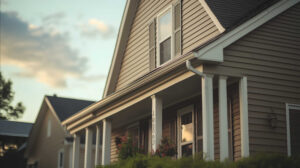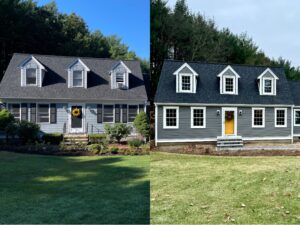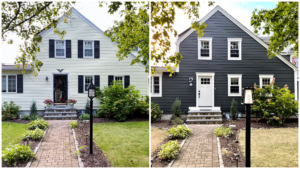
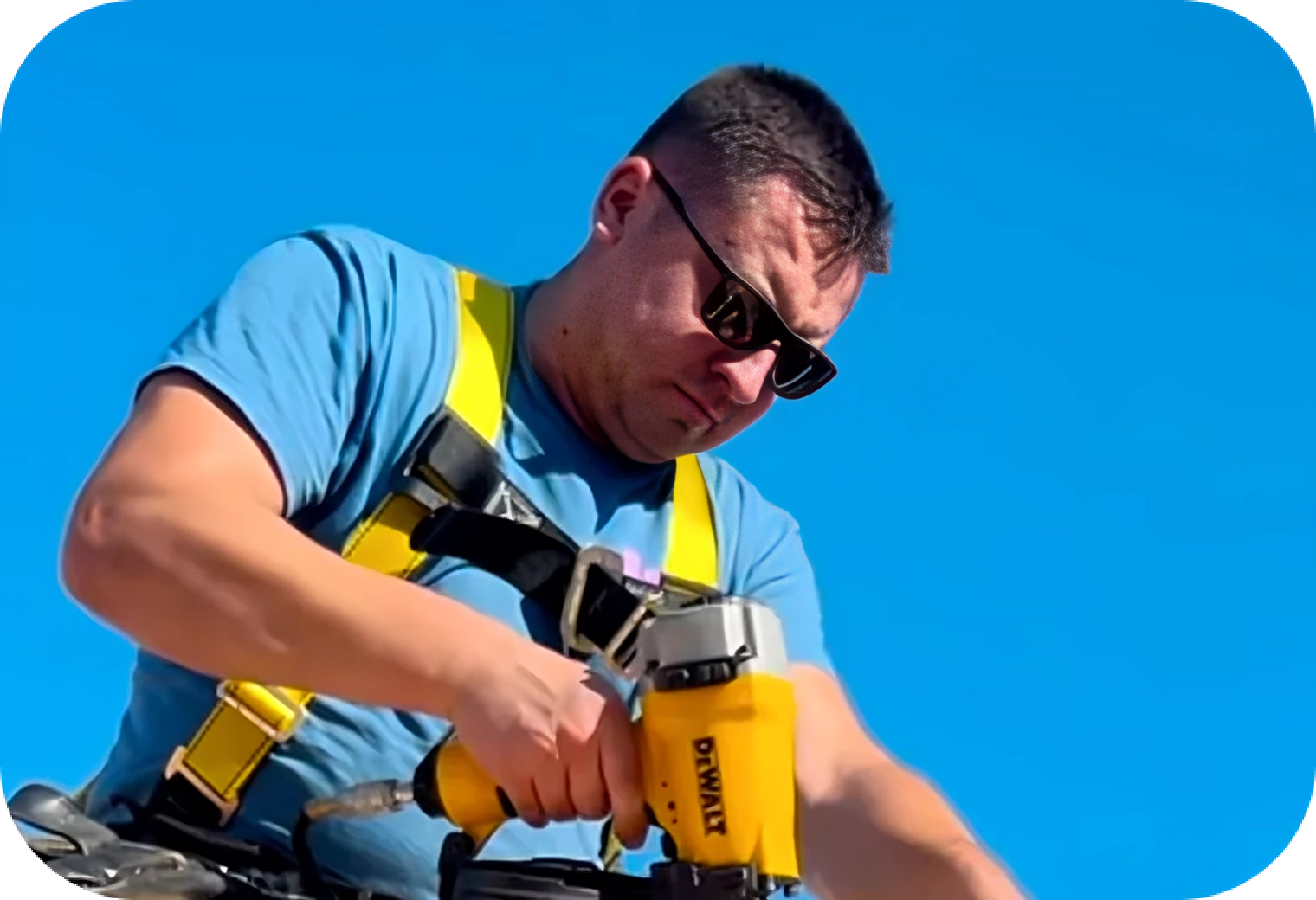
Project Manager at Plum ProExteriors
Vertical vs Horizontal Siding: Find the Perfect Solution

As you might envision, siding is crucial in enhancing the home’s appeal. While color undoubtedly matters, the layout holds equal importance. The debate between vertical and horizontal siding continues to intrigue homeowners seeking the perfect solution for their houses.
Horizontal siding is characterized by long, narrow panels that align parallel to the ground, evoking a timeless and traditional appearance. On the other hand, vertical siding features tall, slender panels arranged perpendicular to the ground, imparting a distinctive and contemporary vibe. The decision between the two styles typically hinges on individual taste, architectural context, and desired visual impact.
In this brief, prepared by our experts, we will consider the vertical and horizontal siding types and what distinguishes them so you can choose the best fit for your home. Let’s start our research!
Vertical siding: overview
Have you ever wondered about the local name for vertical siding? You might be familiar with board and batten siding—it’s essentially the same thing. Vertical board and batten siding are favored for their quaint appeal in small spaces and their ability to impart a contemporary vibe by adding height to structures.
Vertical siding is a wise choice for homeowners who want to highlight distinctive architectural elements. However, it differs from the traditional approach and demands a unique installation method.
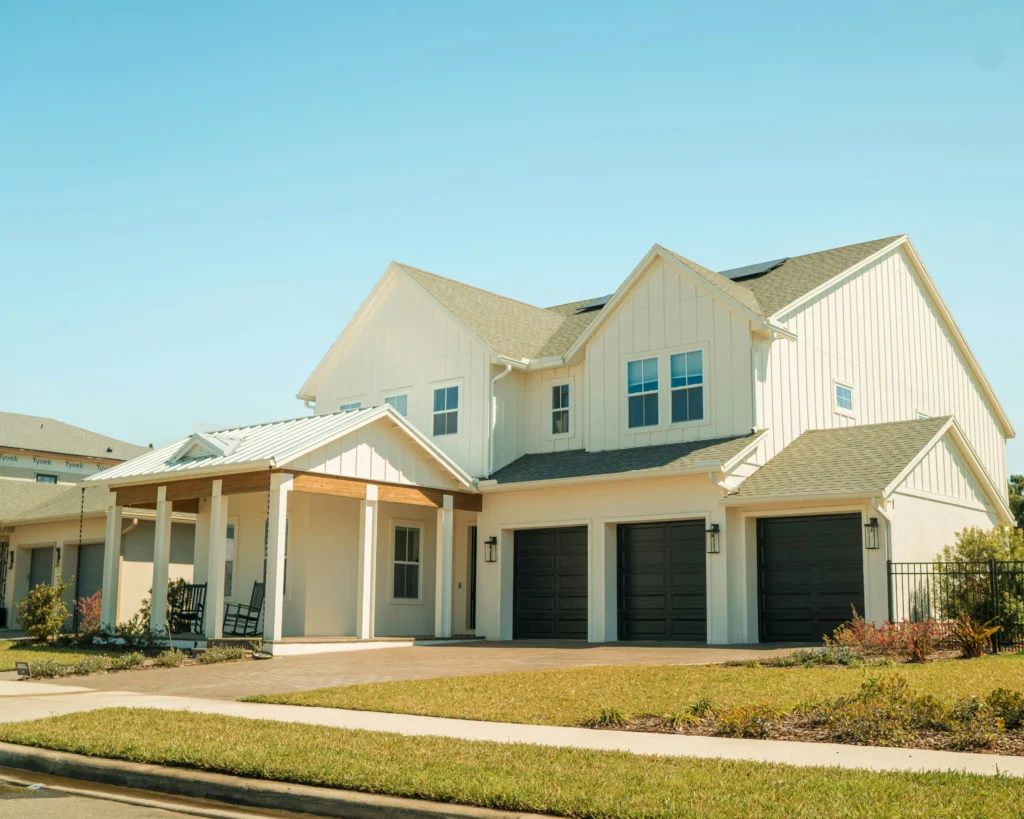
Advantages of opting for vertical siding
- Unique appeal: Vertical siding is a less common choice, but it allows homeowners to create distinctive curb appeal that sets their property apart from the rest.
- On-trend aesthetic: Embrace the sought-after board-and-batten look effortlessly with vertical siding, adding a touch of contemporary style to your home’s exterior.
- Ease of maintenance: Vertical planks facilitate efficient water drainage, minimize dirt buildup, reduce the risk of wood rot, and simplify the cleaning process.
Potential challenges of vertical siding
- Extended installation time: Vertical siding entails additional installation steps, including incorporating furring strips to ensure a smooth surface, resulting in a longer installation process.
- Higher cost: The complexity of installing vertical siding translates to increased labor costs, making it a pricier option than horizontal siding.
- Market perception considerations: While vertical siding can be visually striking, it may not appeal to all potential homebuyers. If you’re contemplating selling your home, consulting with a realtor beforehand can provide insight into whether vertical siding aligns with neighborhood preferences.
Horizontal siding: overview
What’s the common term for horizontal siding in your region? If you mentioned “clapboard or lap,” you’re in line with many others who find these terms more descriptive of this style. Horizontal siding is considered the nation’s top choice, likely due to its ease of installation and durability.
The origins of horizontal siding trace back to America’s earliest homes, where natural wood was commonly used and installed horizontally, imbuing this style with a rich historical legacy. Available in a range of sizes and colors, the long, rectangular panels offer versatility and aesthetic appeal.
While horizontal siding may appear uniform at first glance, seasoned siding contractors like Plum ProExteriors recognize nuances in how the panels overlap.

Advantages of selecting horizontal siding
- Cost-effectiveness: Horizontal siding typically has a lower price point than its vertical counterpart. This makes horizontal siding ideal for those working within budget constraints, updating rental properties, or undertaking house-flipping projects.
- Timeless charm: With its traditional appearance, horizontal siding has long been synonymous with classic house designs, offering enduring appeal that transcends trends.
- Ease of installation: Horizontal siding boasts straightforward and efficient installation processes compared to vertical alternatives, saving valuable time during construction or renovation projects.
Potential challenges of horizontal siding
- Durability concerns: The horizontal ridges inherent in this type of siding can create potential entry points for rainwater. This can lead to issues such as wood rot, mold, and mildew, particularly with wood siding.
- Maintenance requirements: Due to its susceptibility to water damage, horizontal siding necessitates diligent cleaning to prevent moisture infiltration behind the boards. Thus, this type of siding adds an extra layer of maintenance compared to other options.
Vertical vs horizontal siding: price comparison
Below is the cost comparison between vertical and horizontal siding across various siding types. As we mentioned above, the cost of vertical siding installation is a little higher.
| Type of siding | Cost of horizontal siding installation | Cost of vertical siding installation |
|---|---|---|
| Vinyl | $25,000 to $35,000 | $25,000 to $35,000 |
| Engineered wood | $45,000 to $55,000 | $50,000 to $60,000 |
| Fiber cement | $45,000 to $55,000 | $50,000 to $60,000 |
| Cedar | $65,000 to $75,000 | $80,000 to $90,000 |
Please remember that these figures are approximate and may vary depending on factors such as project size, installation complexity, and contractor pricing. For precise pricing tailored to your specific needs, it’s advisable to request quotes from siding professionals.
Factors to take into account before making a choice
Your home highlights your individuality and values, allowing for many possibilities when shaping its exterior appearance. While there are no strict guidelines, if you seek guidance on siding styles tailored to your home, consider the following suggestions to streamline your decision-making process.
Pick siding according to your house style
Choosing the right siding, be it horizontal vinyl siding or vertical fiber cement siding, for your home is a crucial decision that can significantly impact its overall appearance. To help you make an informed choice, we’ve compiled a list highlighting the most suitable siding options based on different house styles:
- Traditional dwellings favor horizontal siding
Horizontal siding remains a timeless choice for a universally appealing aesthetic. This classic design harmonizes seamlessly with historic homes such as colonials, ranches, and Victorian buildings.
- Rustic dwellings prefer vertical siding
Enjoy the look of vertical board-and-batten siding, reminiscent of traditional barns, to enhance the charm of modern farmhouses and craftsman-style homes. Vertical siding also offers a practical solution for elevating the stature of smaller dwellings.
- Explore mix-and-match options for a personalized touch
Break away from convention by incorporating horizontal and vertical siding elements. Consider using horizontal siding for the main structure while introducing vertical accents on gables to add visual interest. This modern approach often benefits architecturally complex homes.
Consider siding durability
While aesthetics are undeniably crucial, the durability of siding materials is equally paramount. Horizontal siding, typically engineered for resilience by leading manufacturers, faces a common challenge over time: moisture retention along its edges, potentially leading to deeper structural issues.
Engaging a skilled professional for horizontal siding installation can mitigate longevity concerns, as improper installation often shortens the lifespan of any siding material. Additionally, material choice significantly impacts durability; inadequately maintained wood, for instance, is prone to warping, hindering moisture runoff.
In cases where moisture buildup is inevitable, horizontal siding can be selectively repaired, sparing homeowners the expense of a full replacement. Collaborating with a reputable siding contractor ensures both appropriate product selection and flawless installation, safeguarding long-term investment.
Consider long-term siding maintenance
Vertical siding boasts effortless cleaning, simplifying long-term maintenance with minimal complexity. In contrast, horizontal siding, particularly its notorious edges, poses cleaning challenges. Real wood variants, like cedar, are susceptible to warping over time, demanding consistent maintenance to safeguard investment.
Consulting with siding experts can guide homeowners on the optimal cleaning products and maintenance schedules for wood siding. Professional intervention ensures effective cleaning for horizontal siding, highlighting the importance of using appropriate materials and techniques for optimal results.
Consider resale value
When it comes to siding, its significance extends beyond mere curb appeal. While a visually appealing exterior can expedite a home’s sale, opting for high-quality siding and professional installation ensures long-term protection, enhancing the property’s inherent value. However, the vertical versus horizontal siding dilemma raises questions about resale prospects.
Real estate experts often advocate for adhering to conventional or traditional norms when making home improvements for resale. For instance, they discourage unconventional paint colors to maintain broad market appeal. Consequently, many advise against vertical siding installation, favoring the traditional horizontal option. Nevertheless, vertical siding can infuse certain homes with a striking visual appeal that sets them apart in the market.
Create a budget for the siding project
Establishing a financial plan for your siding installation venture is crucial for its success. While some may be tempted to cut corners by opting for the cheapest materials and contractors available, this approach may compromise the overall quality and durability of the project. Instead, crafting a budget that prioritizes investing in high-quality materials and reputable professionals for reliable and long-lasting results is imperative.
Choose a reliable siding services company
It is vital to pick a reliable siding services contractor. At Plum ProExteriors, we specialize in installing vertical, horizontal, and mixed siding options. We use only proven materials, such as James Hardie, Everlast, and others, to maximize the value and longevity of your home exterior remodel. Our team prioritizes your preferences and offers tailored solutions, ensuring a home you can take pride in for years.
Can I use both vertical and horizontal siding?
When pondering exterior aesthetics, the question arises: Can I integrate horizontal and vertical siding? Indeed, the fusion of these two styles presents an exciting opportunity. By strategically intertwining vertical accents with horizontal panels, you can infuse your home with depth, texture, and architectural intrigue.
A popular tactic involves employing vertical siding on gables or dormers to add vertical emphasis and elevate the roofline’s visual appeal, while horizontal siding harmonizes with the main structure. This combination of siding enriches curb appeal and architectural allure.
Below, you can see some examples of mixing vertical and horizontal siding.

Furthermore, blending siding orientations allows bespoke customization to suit diverse architectural styles and personal tastes. Whether pursuing a contemporary vibe or a classic ambiance, the flexibility of combining vertical and horizontal siding opens doors to endless creative expressions.
Yet, achieving a seamless and coherent ensemble demands meticulous planning and execution. Factors like color harmony, proportion, and architectural context must be carefully considered. Collaboration with seasoned siding professionals or design experts ensures a flawless integration that enhances your home’s overall charm.
In general, the combination of vertical and horizontal siding presents a versatile and captivating avenue for exterior design. By thoughtfully intertwining these styles, you can elevate your home’s architectural integrity and overall look.
Conclusion
The decision between vertical and horizontal siding hinges on personal preferences, architectural context, and the desired aesthetic impact. You should carefully weigh the pros and cons of each option and consider factors such as cost, durability, and maintenance requirements.
Whether you opt for the timeless elegance of horizontal siding or the contemporary flair of vertical panels, the main goal remains the same: to create a home exterior that reflects your unique style and leaves a lasting impression.
If you need help installing or painting siding, opt for an experienced siding services team. Choose Plum ProExteriors, and you will gain access to a skilled team with vast experience executing siding projects. Contact us today, and we will make your home look modern and stylish!
